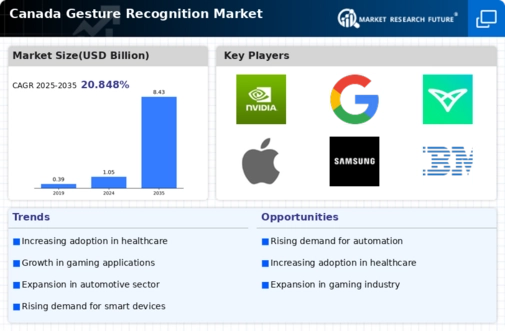Advancements in Sensor Technologies
Technological advancements in sensor technologies are significantly influencing the gesture recognition market in Canada. Enhanced sensors, including depth cameras and motion detectors, are enabling more accurate and responsive gesture recognition systems. These innovations are crucial for applications in gaming, virtual reality, and smart home devices, where precision and reliability are paramount. The integration of advanced sensors is expected to drive market growth, with projections indicating that the gesture recognition market could expand to $1.8 billion by 2027. This growth is indicative of the increasing reliance on sophisticated gesture recognition systems across various industries, as companies strive to enhance user engagement and interaction.
Rising Adoption in Automotive Sector
The automotive sector in Canada is increasingly adopting gesture recognition technologies, emerging as a key driver for the gesture recognition market. As vehicles become more technologically advanced, manufacturers are integrating gesture-based controls to enhance driver safety and convenience. This trend is particularly relevant in the context of infotainment systems, where gesture recognition allows drivers to interact with their vehicles without diverting attention from the road. Industry reports suggest that the automotive segment could account for over 30% of the gesture recognition market by 2025, highlighting the potential for growth as more automakers embrace this technology to improve user experience.
Increasing Demand for Touchless Interfaces
The gesture recognition market in Canada is experiencing a notable surge in demand for touchless interfaces. This demand is driven by the growing consumer preference for hygienic and convenient interaction methods. As businesses and consumers alike seek to minimize physical contact, the adoption of gesture-based technologies is becoming more prevalent. This shift is particularly evident in sectors such as retail and healthcare, where touchless solutions enhance user experience and safety. According to recent estimates, the market for gesture recognition technologies is projected to reach approximately $1.5 billion by 2026, reflecting a compound annual growth rate (CAGR) of around 25%. This trend indicates a robust growth trajectory for the gesture recognition market, as organizations increasingly invest in innovative solutions to meet evolving consumer expectations.
Growing Interest in Augmented Reality Applications
The gesture recognition market in Canada is witnessing a growing interest in augmented reality (AR) applications, driving innovation and investment. As AR technology becomes more mainstream, the demand for intuitive gesture-based controls is increasing, particularly in gaming, education, and training sectors. The ability to interact with virtual objects through natural gestures enhances user engagement and immersion, making it a valuable asset for developers. Market analysts project that the AR segment could contribute significantly to the gesture recognition market, potentially reaching $2 billion by 2028. This trend underscores the importance of gesture recognition technologies in creating seamless and interactive AR experiences.
Government Initiatives Supporting Technology Adoption
Government initiatives in Canada aimed at promoting technological innovation are positively impacting the gesture recognition market. Various funding programs and grants are being introduced to support research and development in emerging technologies, including gesture recognition. These initiatives encourage collaboration between public and private sectors, fostering an environment conducive to innovation. As a result, companies are more likely to invest in gesture recognition technologies, leading to enhanced product offerings and market growth. It is estimated that government support could catalyze a market expansion of approximately 20% over the next five years, reflecting the critical role of public policy in shaping the future of the gesture recognition market.





















Leave a Comment